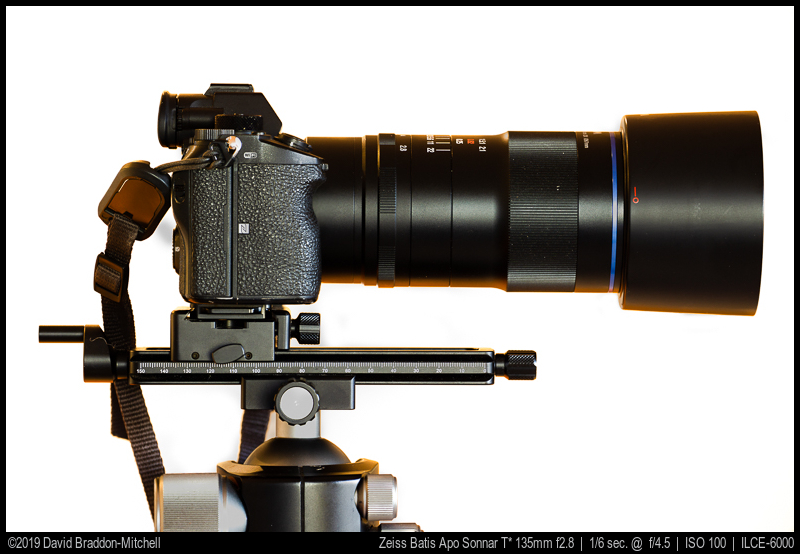
This lens costs $449. It’s a 100mm f2.8 macro, which focuses down to twice life-size. A feat no other lens in its class achieves. It also focuses to infinity. It claims to be apochromatic. How good can it be? Is it, as some suspected when they first heard about it, good for macro but only an emergency lens for infinity use? Or is it the deal of the century? I’m afraid I’m going to make you read further if you want to find out!
UPDATE at the end I have some info which might make the lens more attractive than most of my review suggests.
Samples
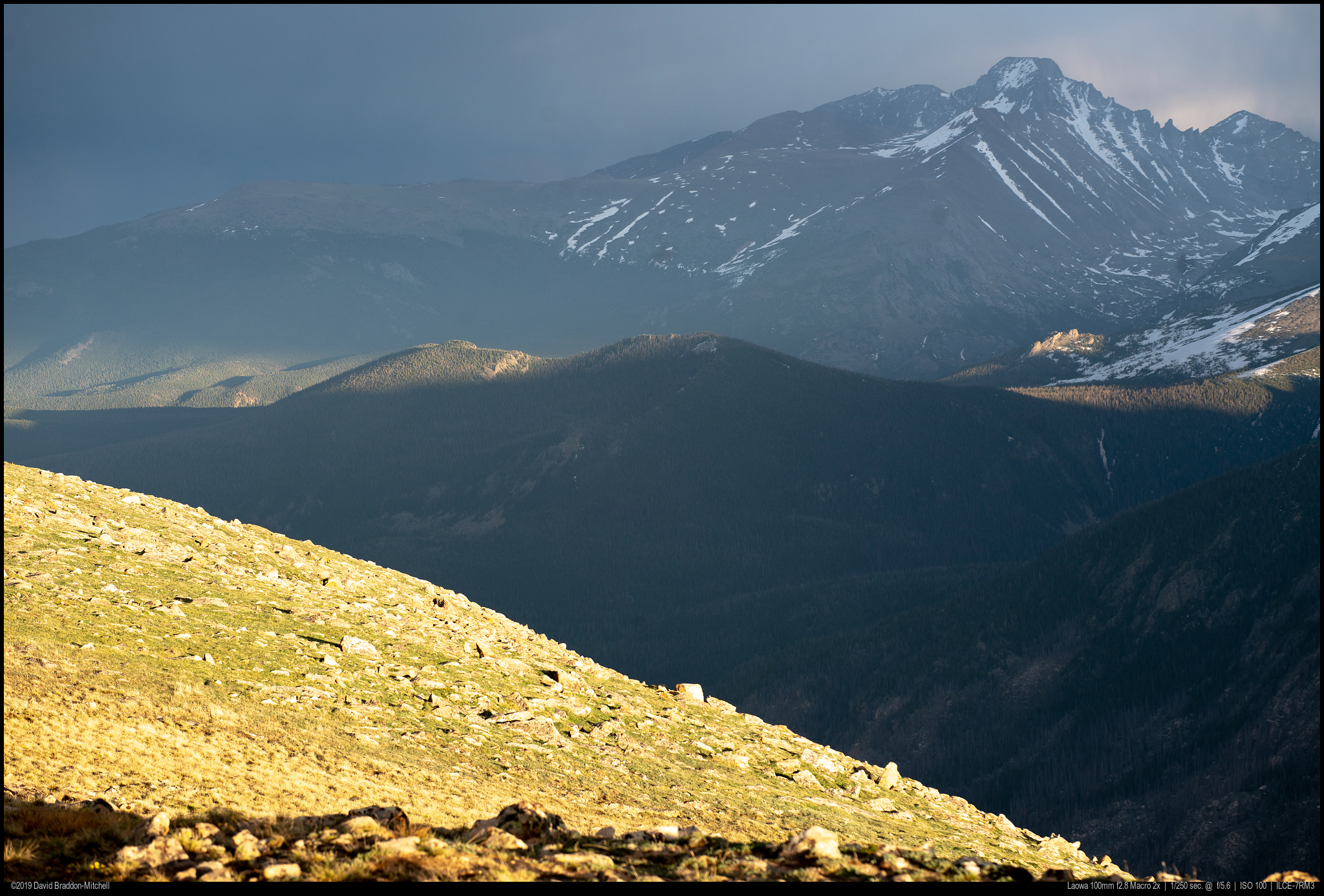
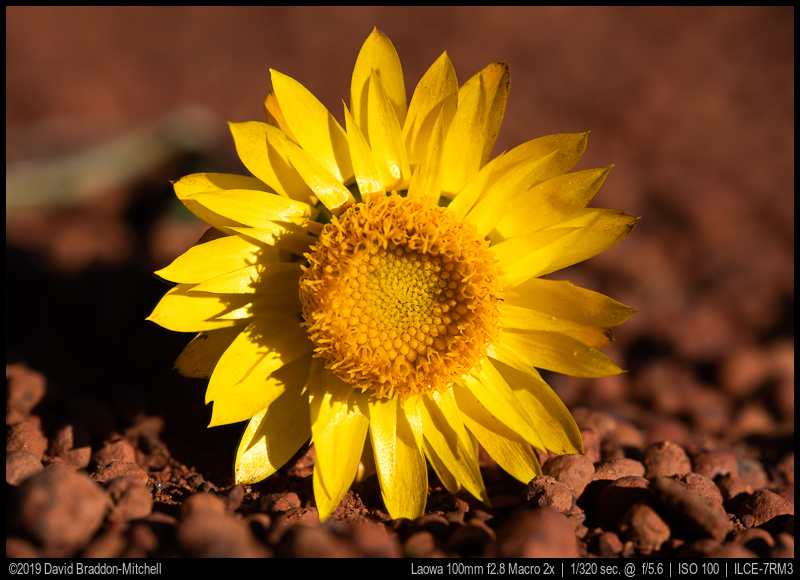
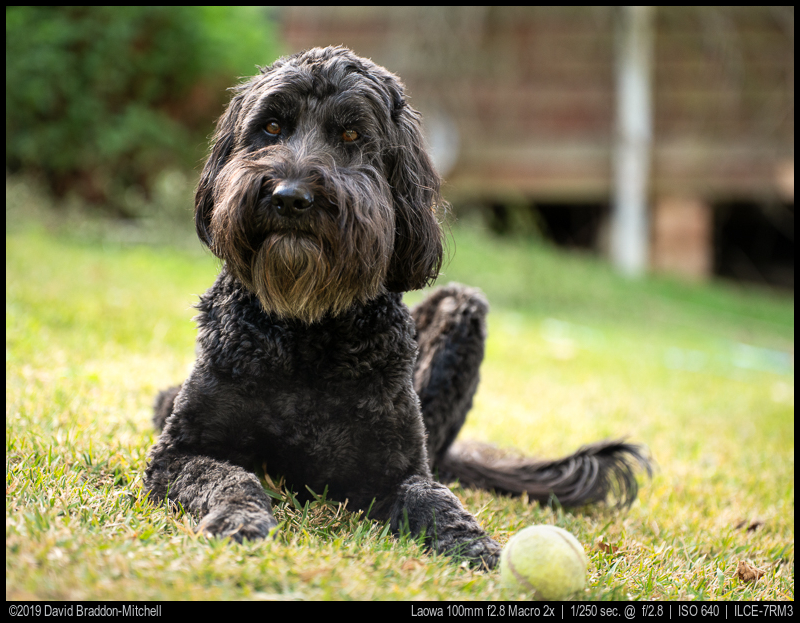
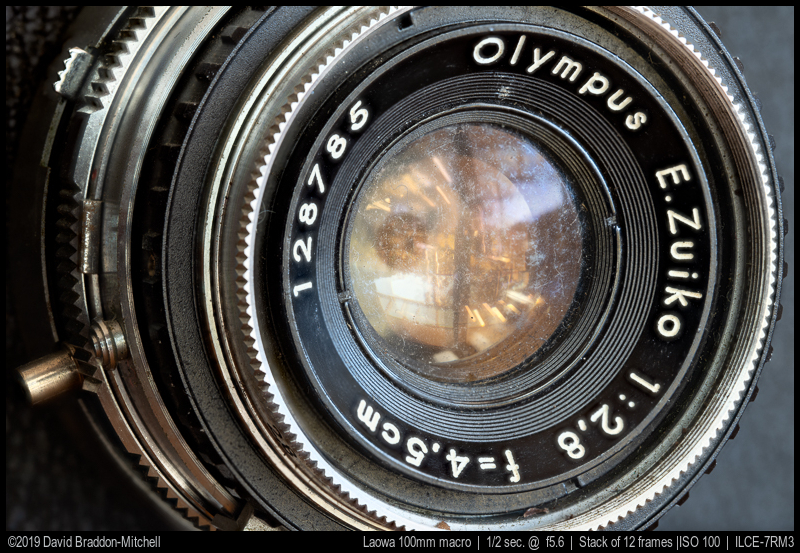
Contents
- Samples
- Specifications
- Features, Build Quality and Handling
- Infinity Resolution
- Portrait Distance Resolution
- Macro Distance Performance
- Optical Vignetting at Non-Macro distances
- Vignetting (Corner Shading)
- Chromatic Aberration
- Distortion and Distortion Correction
- Flare
- Alternatives
- Conclusion
- More Samples
- David Braddon-Mitchell
- Latest posts by David Braddon-Mitchell (see all)
Specifications
| Diameter | max 72 mm |
| Length | 155 mm |
| Filter Thread | 67 mm |
| Weight (w/o adapter) | 657 g |
| Minimum Focusing Distance | 0.247m |
| Maximum Magnification
Working Distance at Max Mag |
2:1
71mm |
| Number of aperture blades | 13 |
| Elements/ Groups | 12/10 |
If you are interested in purchasing it, buying it from one of these affiliate links makes a small contribution to defraying the cost of this blog. You can get it at:
Features, Build Quality and Handling
The build quality of the lens is very good indeed.While perhaps not quite as refined as the latest Voigtländer or Zeiss builds, it is tightly constructed from metal with what seems like a durable and attractive finish.
The lens does not change in length as you focus from 2x life-size (about 25cm) to infinity. But it’s not internal focus: the trick is that there is an outer barrel, and as you focus closer, the lens extends inside that outer barrel. At closest focus the front element gets very close to the end of that barrel, almost touching any 67mm filter you have attached (filters screw onto the end of the outer barrel).
This outer barrel has a thin lining of grease on the inside, helping presumably to allow the mechanism inside the barrel to move for focusing despite the short throw. A review on another website was very concerned about this, noting that dust will get caught in the grease with unfortunate results. My copy of the lens came with a clear filter screwed onto the outer barrel, leaving the inner barrel completely sealed. It is probably essential to keep this filter in place to prevent dust mixing with the grease.
The focus ring is very heavily damped, and is perhaps a touch stiffer than ideal. This may in part be because of the extremely short throw: perhaps 100 degrees between twice life size and infinity. This is not a lot of throw even for a non macro lens. But being a macro, it leaves you with only a tiny distance to turn the lens between 1 metre and infinity. This can make the lens tricky to focus at normal distances, though it’s not impossible.
The lack of throw at macro distances doesn’t worry me as much: it just encourages you to focus by moving the camera, which is what many people do with macro in any case. If you are hand-holding, moving the camera slightly is easy. On a tripod it’s less easy unless you have a focusing rail. But this is a 2x lens – at those magnifications a rail is a good idea anyway.
The Sony version, reviewed here, has no electronic contacts so there is no EXIF, and stabilisation will be 3 axis. The Sony version has one unusual feature other versions lack: a 13 blade iris! As you’ll see in the bokeh section, this appears to pay off rather well.
Infinity Resolution
Here’s the usual infinity resolution image. As usual recently, I have taken to moving the camera so as to get the same subject in each location, to make comparison easier. I focussed when the subject was central, and did not change focus for midfield (intersection of rule of thirds lines) and extreme corner.
Centre and mid frame are both very good from wide open. The extreme corner is OK until f5.6 when it crisps up nicely. It never gets quite as good as the other areas of the frame. It does however improve quite quickly away from the corner. I’d say this is impressive for a lens which can do twice life size macro; it’s about as good as most top lenses over a large part of the frame.

To get a sense of how this compares, I ran some comparisons with the Voigtländer 110mm Apo-Lanthar. The Apo-Lanthar has a slight advantage in that it is very slightly stopped down when set to f2.8.
But in the corners, the Voigtländer is better at all apertures, and so it should be at the price (it doesn’t go beyond 1:1 either, which makes infinity correction easier).
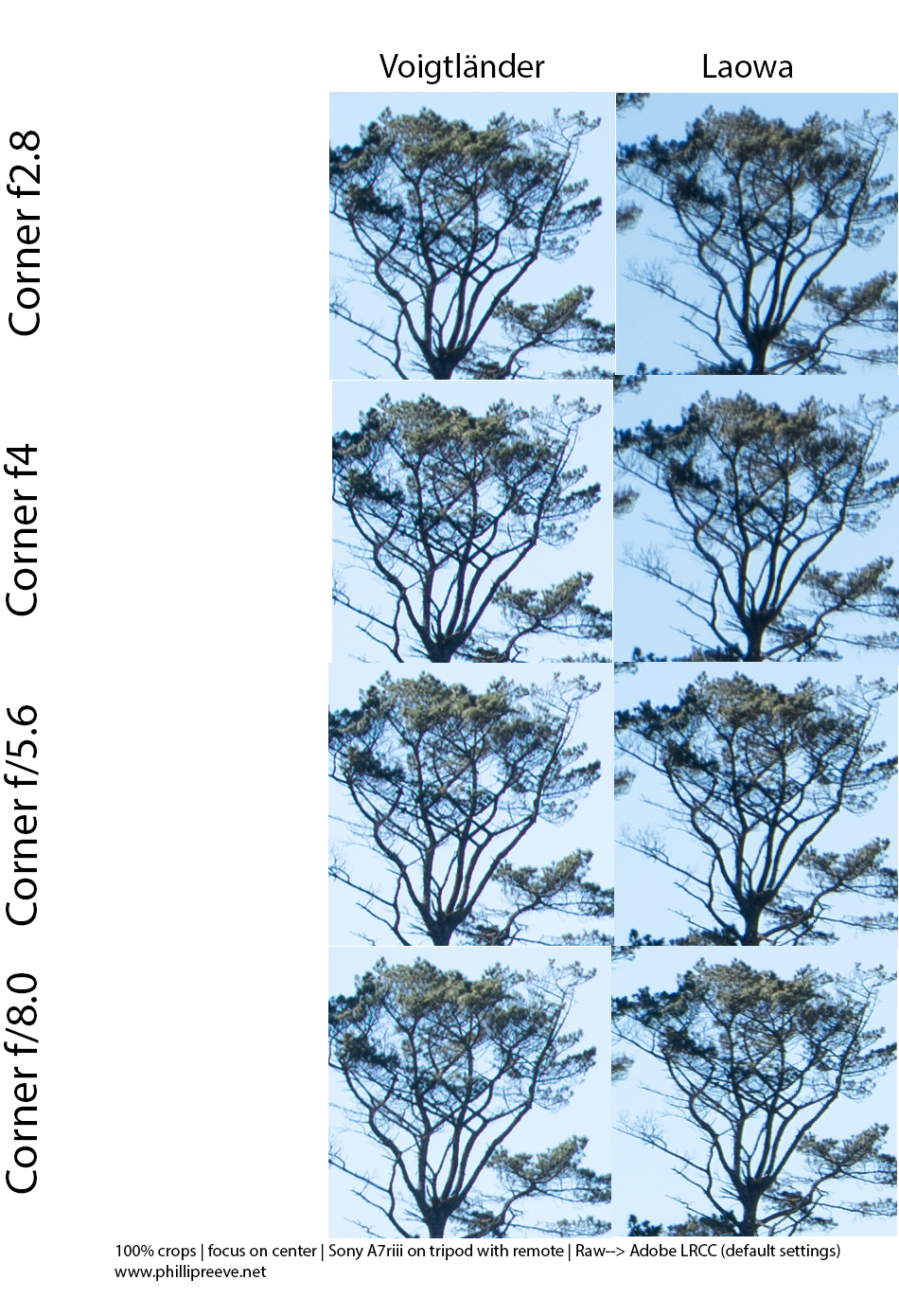
Things get much closer in the mid frame:
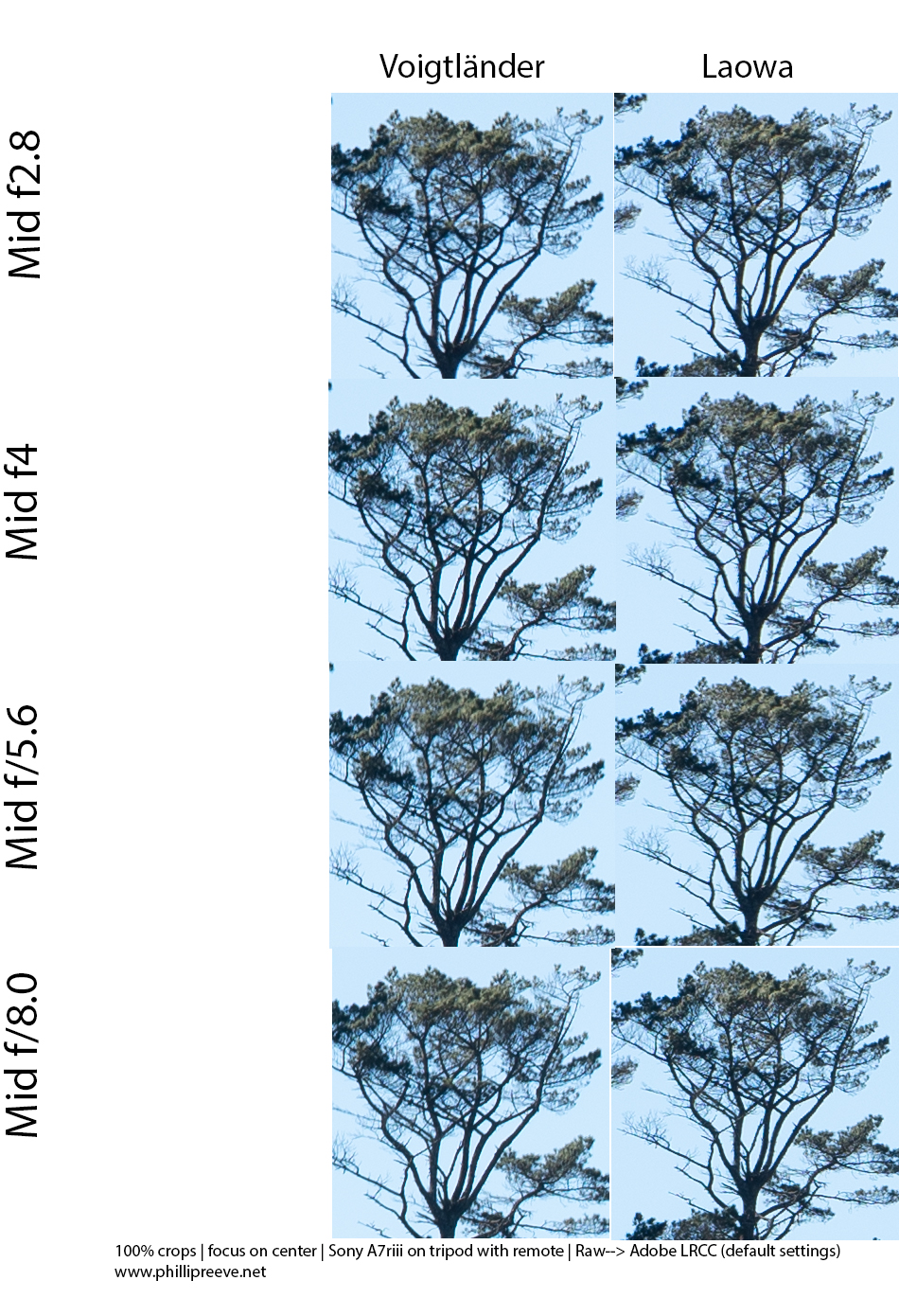
Here, while the Voigtländer may have a touch more contrast, the Laowa is pretty much comparable. In the centre the lenses are hard to tell apart.
If you are looking for a tele lens to use at infinity, the Voigtländer is likely the best there is. But if you want a high magnification macro, but need to be able to get good image quality at infinity, the Laowa will do the job very well, unless you for some reason need high infinity resolution at wide apertures in the corner, which is a rather unusual use case.
Portrait Distance Resolution
One of the primary uses of a general short tele lens is for portraiture. Many buyers of this lens may want it, therefore, to double as a portrait lens. What matters here is not so much even resolution across the frame, but that the eye of your subject, at whatever place you put it in the frame, is sharp when you focus on it. In past reviews I have used a live subject and focused on their eye, but this both requires a cooperative friend, and is subject to possible movement.
Instead I have focused on bank notes, which we also often use for MOD (minimum object distance) tests.
I focused at 2.5 metres, which is a nice half-body to head-and shoulders distance for portraiture. I focussed first in the centre, and then at the rule-of-thirds intersection. Any further into the corners in an unlikely location for an eye in a portrait.
For reference, the two eyes of the Ben Franklin in this image together are about as wide as a regular human eye. This is at 1:1 pixel dimensions
First, wide open at f2.8. Left is centre, right rule of thirds intersection.
Second stopped down to f4.0: again left is centre, right is rule of thirds intersection.
This is good performance. Bearing in mind that a real human eye occupies the same size as both eyes and the area between them in the banknote, at portrait distance this shows that it doesn’t matter much where you place your eye or what aperture you use. Still, there is a slight drop in contrast and resolution off centre even stopped down a stop. It’s still good, and fine for portraiture, but my impression is that these intermediate distances (neither infinity nor macro) may be where the lens is least optimised.
One issue for portraiture is that there is remarkably little throw on the focus ring. When handholding you are better off moving the camera rather than using the focus ring, even at portrait distances, which is not ideal.
Macro Distance Performance
Here’s the coin I am using as a subject:
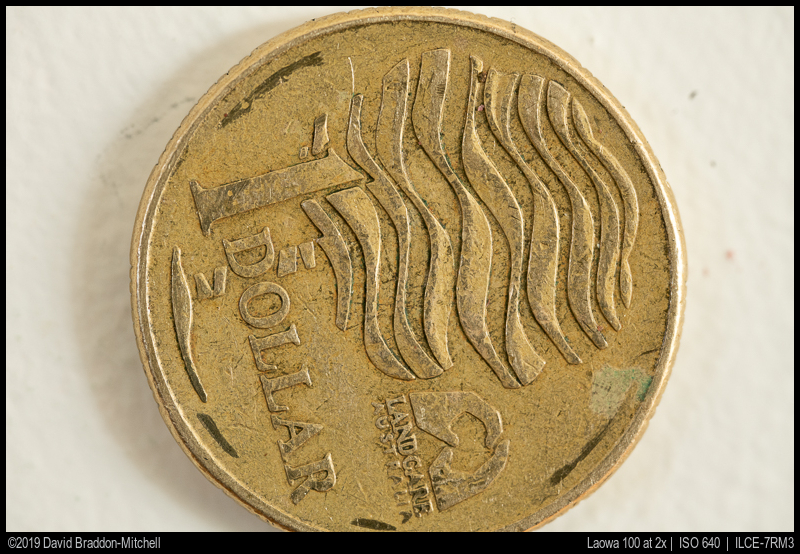
Performance is even across the field, provided you focus on the different areas, so I have chosen representative samples to show at 1:1. However there is a just touch of field curvature, with focus moving back a little at the periphery. But I think planar subjects will be very unlikely subjects for a macro lens like this. It may, however, mean that if you interest is eg. in photographing postage stamps that you should evaluate the lens yourself before committing.
First lets look at the performance at 2x magnification. representative sample I’ve chosen is at the rule of thirds intersection. I’ve displayed both wide open and f5.6. These are all 100% crops.
Macro resolution is very hard to represent, and we are still working on the ideal solution (a slide with engravings that could be put into a slide holder).
The performance here is very good for 2x; at perhaps as good as the canon MPE is in resolution terms with better colour correction.
Two things to note: depth of field is extremely thin, so you can see on this Australian one dollar coin, that the recessed parts are completely OOF.
The other thing to note is that at 2x magnification diffraction is very high: so the best performance tends to be wide open. Here you will see that although DOF increases as you stop down, actual resolution does not. But peformance at f5.6 is adequate, so I might choose this aperture for stacking as the extra DOF makes the workflow easier (fewer images) and the resolution drop is not too severe (by f8 it tends to be)
Now lets look at 1:1 resolution, which is the closest most macro lenses will focus.
Here is a sample of the fairly even performance at life size; again focus is on the raised areas. Performance is again diffraction limited wide open. There’s no improvement as you stop down.
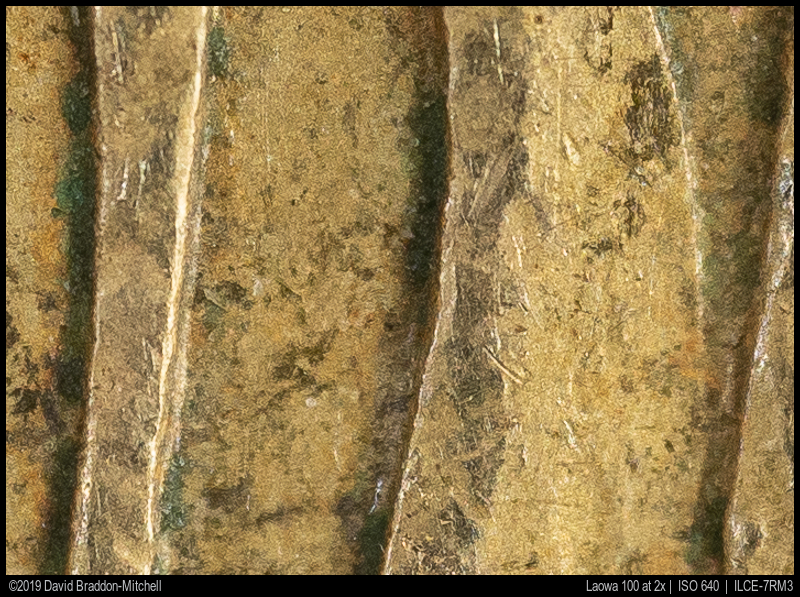
One final thing to note is that there is a touch of focus shift in the macro range. Focus shifts back just a little as you stop down. For for subjects where this is crucial where you want to shoot one or two stops down, focus at the taking aperture. This is not much of a constraint on the whole: when you are focus stacking, exact focus on a particular frame doesn’t matter. It will only matter if shooting single frames with a crucial focus demand like an eye of a bug. But in that case focussing wide open and stopping down to shoot isn’t practical in any case.
Macro Bokeh and Optical Vignetting
Here is something pretty astonishing. First, when focussed at life size the bokeh balls for highlights between 10 and 20 cm being the subject plane, are larger than on similar lenses. I don’t know why this is, but it’s nice. Also in macro situations it has remarkably little cat’s eye effect: in macro conditions it’s better than the Sony 90 in this regard, which is in turn better than the CV 110.
So the 13 blade aperture on the Sony version really does its job. There is no sign of edges at any aperture from wide open to f11! There’s also no sign of colour outlining either, further testament to the excellent colour correction.
Optical Vignetting at Non-Macro distances
At the wides apertures most lenses cut off the bokeh balls so they are not perfectly round. This has two effects: one is that when there are specular highlights in the background, instead of being round, they are “cat’s eyes” in the corners. The other effect is that this slight deformation of out of focus structures makes the background swirl a little. Some people seek out old designs that have huge amounts of optical vignetting to achieve this swirl (such as the Helios 44-2).
optical vignetting (the phenomenon is sometimes called mechanical vignetting though these are slightly different phenomena: we’ll have an article explaining this later) is not as impressive as at macro distances, but still good.
Here is wide open at f2.8.
Left is the extreme corner, mid is rule of thirds intersection, right is centre.
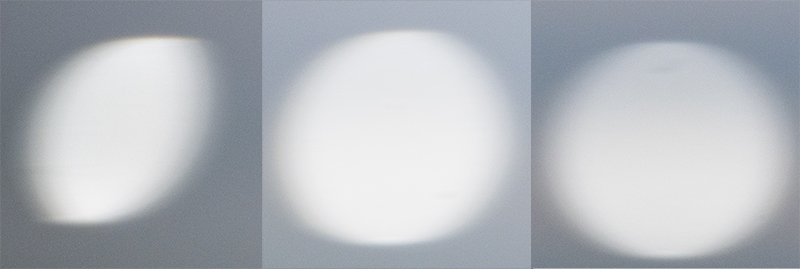
Performance is not astonishing like it is at macro distances, but it is very good nonetheless. The cat’s-eye effect in the corner is almost gone at the next f-stop and quite gone by f5.6. At every aperture there are no straight edges to the aperture: the 13 bladed iris does its job very well indeed.
Vignetting (Corner Shading)
Vignetting in this sense is a lack of even illumination across the image field. It is the result of a mixture of causes; usually optical vignetting and natural vignetting. Natural vignetting is the residual vignetting which is not reduced by stopping down. The increase in vignetting relative to this at wider apertures is usually another effect of the optical vignetting we discussed above.
Macro lenses often behave very differently at infinity and at macro distances, with vignetting being much reduced at close distances. So I have measured vignetting for two focus settings: Life-size (1:1) and infinity.
At life-size vignetting is very well controlled; around .7 of a stop wide open and negligible stopped down.
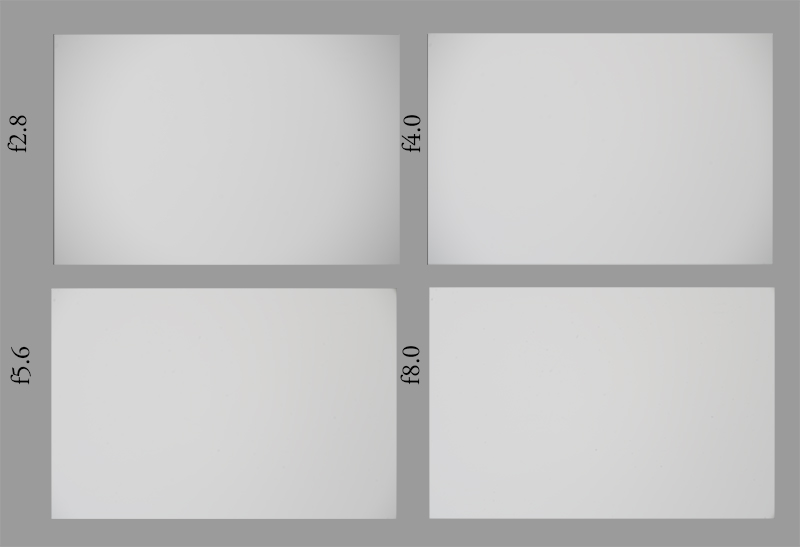
At infinity vignetting is somewhat stronger, at about two stops wide open, but again negligible by f8. This is also good performance.
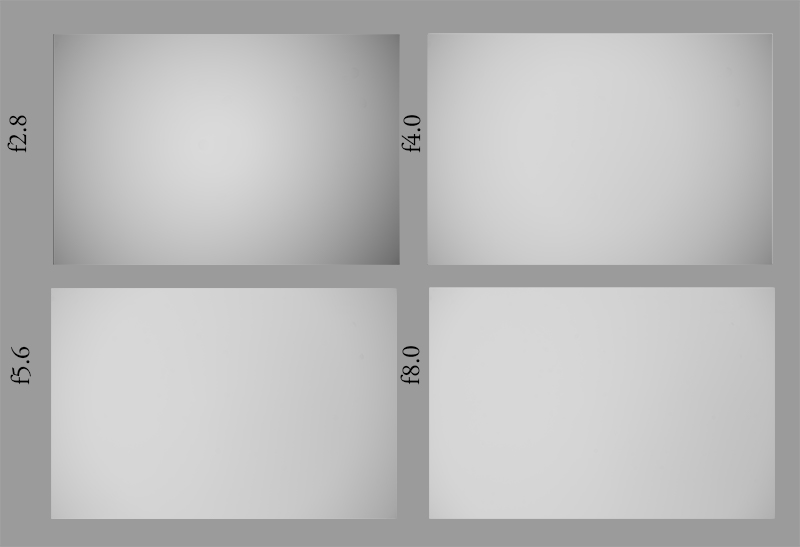
Chromatic Aberration
There is almost no visible LaCA despite the fact that it doesn’t have contacts, and so there is no auto correction happening.
And, the amazing news is, no visible LoCA. It’s an apochromatic lens, with better colour correction than many lenses advertised in this way.
Distortion and Distortion Correction
The lens exhibits very mild pincushion distortion, which can be fixed completely when needed with a setting of -3 in Lightroom.
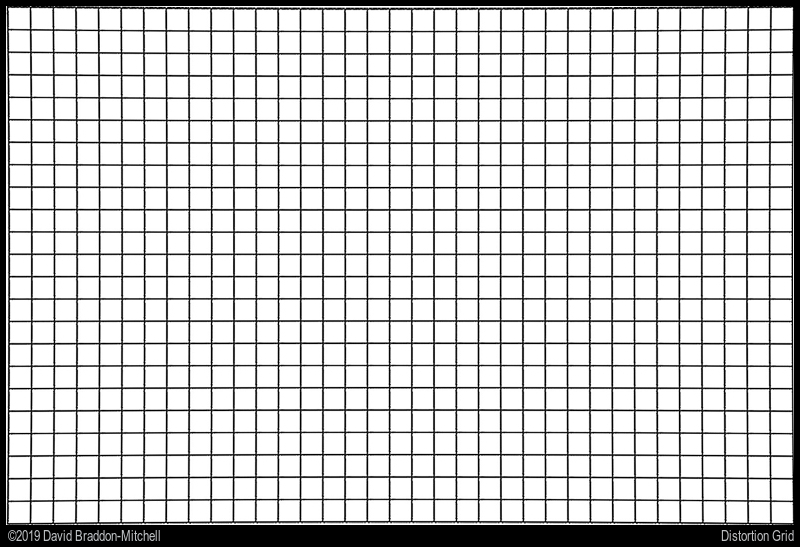
Flare
The lens is somewhat prone to veiling flare when the sun is just out of the frame. Even at infinity, where the front element is well recessed into the body, you can get some fairly strong effects. Here’s a typical example, combined with my best efforts to use hood and and hand to minimise flare. Probably it could be eliminated using a longer cardboard tube to completely shade the lens.
Flare with the sun in the frame is quite strong, with a very pronounced ring flare effect. This could be problematic for backlit portraits: although on occasion it can be an attractive effect, ideally better performance than this would be good.
The ring flare is very strong wide open, still problematic at f4 but is under control by f8
Sunstars
There are’t any really. That’s inevitable with the 13 blade aperture that gives such nice performance in the macro range.
Alternatives
Sony G 90mm f2.8 Macro
Reviewed by Phillip here. This is Sony’s entry in the short tele macro field. Its very good at longer distances, and absolutely superb at macro distances. It has great macro bokeh, better than most of the competition, but the Laowa may be a touch better. The Sony has better contrast and all the conveniences of AF (with an ususual but in my opinion great MF system, where you have the choice of a quick shorter throw linear MF system to set magnification, or a longer throw system for precise focus. More expensive. Also, like most of the competition, can’t go to 2:1
Canon MPE 1-5x 65mm
This is a specialist lens that is how I have got 2x magnification before the Laowa arrived. It is a macro only lens which does not focus to infinity (or focus at all, actually, the ring just selects magnification, you move the lens to focus). I think the Laowa is perhaps as sharp at 1x and maybe 2x, and the Laowa has better bokeh and colour correction. Bokeh may not matter much at high magnifications, though, because to avoid diffraction you will be likely shooting wide open (where the aperture blades play no role) and focus stacking.
Voigtländer 110mm f2.8 Macro Apo-Lanthar
Reviewed by Phillip and me here. This is definitely the best of the available modern 100-ish lenses at from half life size out to infinity. Incredibly sharp, incredibly contrasty and with great sunstars. But at life size the Laowa is as good (and realistically close enough at most settings) and of course the Laowa goes all the way to twice life size.
Legacy options
There is a review of the revered Tokina here; I would pay the extra for the Laowa though. Some of the slightly older Sigma AF macro lenses are very good indeed. The Sigma AF 70mm F2.8 EX DG Macro (not the new ART) macro was legendary in its time, and the Sigma 105mm f/2.8 EX DG is very good too. Either could be a good budget choice for use on an adapter (you probably should look for the Canon mount version) if you only need 1:1 and AF appeals.
Conclusion
good
|
average
|
not good
|
This is a very strong recommendation for the macro enthusiast. You are getting a lens that will focus to twice life size which normally only highly specialised and expensive lenses will do, and with quite decent working distance. While I don’t go to twice life size often, I do often like to get just a bit closer than life size, and this lens lets you do that without cropping. Its performance at twice life size is very good, as is its performance throughout the macro range. Remarkably for a lens with these specialised abilities, it’s also a very good performer out to infinity, with only slightly lower extreme corner resolution, contrast and flare performance to distinguish it from the absolute best lenses ever made with these specifications.
There are two sorts of buyers that should buy this lens immediately. The first is the macro enthusiast (though perhaps not the stamp collector) who wants a short tele macro that goes to 2x. There is no competition, and it performs very well. The other is the buyer who might not often need 2x, but wants a tele macro lens and doesn’t have deep pockets. If she buys this lens, she gets one that for macro purposes is in most respects as good as it gets, and for general purposes is very good while being a lot cheaper than the lenses that are a little better.
If you are interested in purchasing it, buying it from one of these affiliate links makes a small contribution to defraying the cost of this blog
UPDATE
As you can see most of this review concentrated on the performance of the lens as a general purpose lens, and at usual macro magnifications. I did not test it extensively at 2x, because I thought that was something of a party trick: we do not expect and infinity focussing lens to do well at 2:1. So I tested it briefly, and was surprised at how good it was, saying “probably as good as the Canon MP-E”
I underestimated it. I don’t currently have a copy, but the excellent Richard O’Toole has tested it extensively at 2x (https://www.closeuphotography.com/2x-lens-test-2022) and indeed it’s outstanding for the money, and excellent by any lights at 2x.
Given it’s fine performance art 1x, it’s a strong recommendation for the real macro enthusiast. My previous caveats of course apply. If what you want is a great general purpose short tele, with excellent 1:1 other lenses are better. Although not cheaper. But if you expect to work largely in the 1x to 2x range, this lens is very strong reccomendation.
You can purchase the Laowa 100mm f2.8 CA-Dreamer Macro 2x via our affiliate links from: https://www.closeuphotography.com/2x-lens-test-2022
More Samples
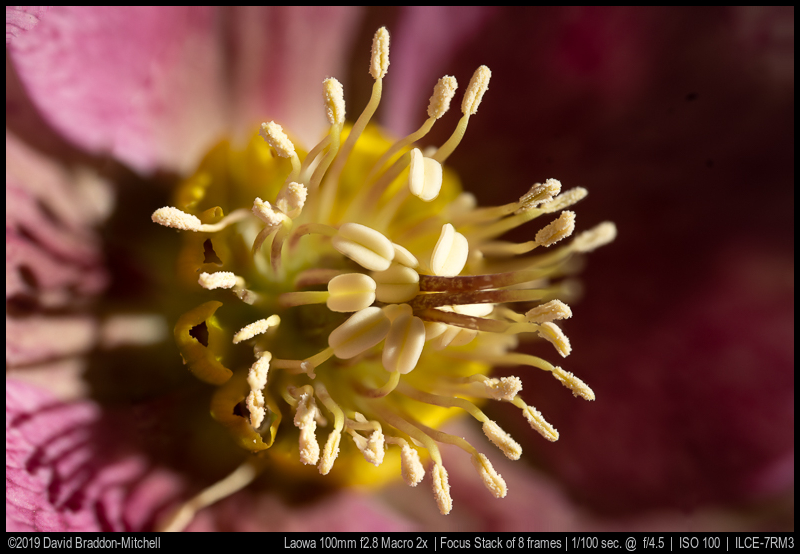

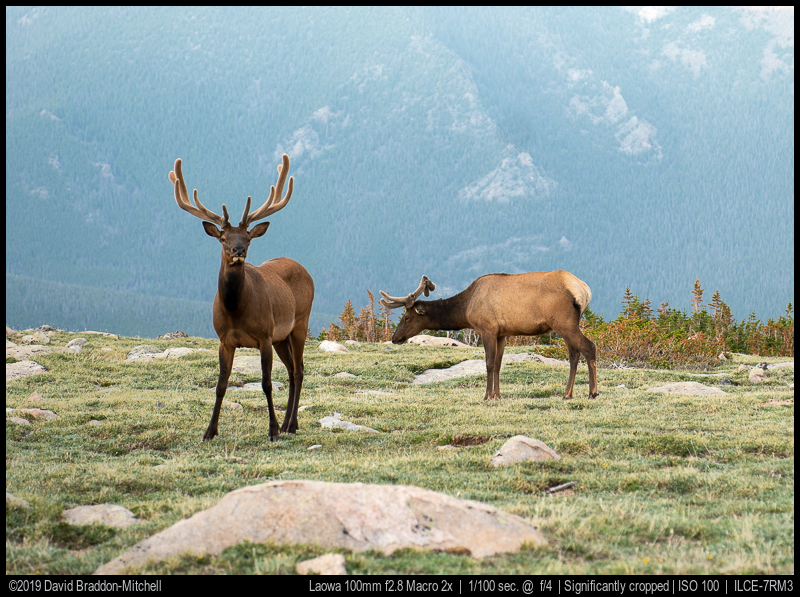
This site contains affiliate links. If you make a purchase using any of the links marked as affiliate links, I may receive a small commission at no additional cost to you. This helps support the creation of future content.
David Braddon-Mitchell
Latest posts by David Braddon-Mitchell (see all)
- Laowa FFii 90mm F2.8 CA-Dreamer Macro 2x: getting close! - August 21, 2022
- FLM Ballheads: a rediscovery - February 4, 2021
- Laowa 14mm f4 Detailed Review - December 31, 2020









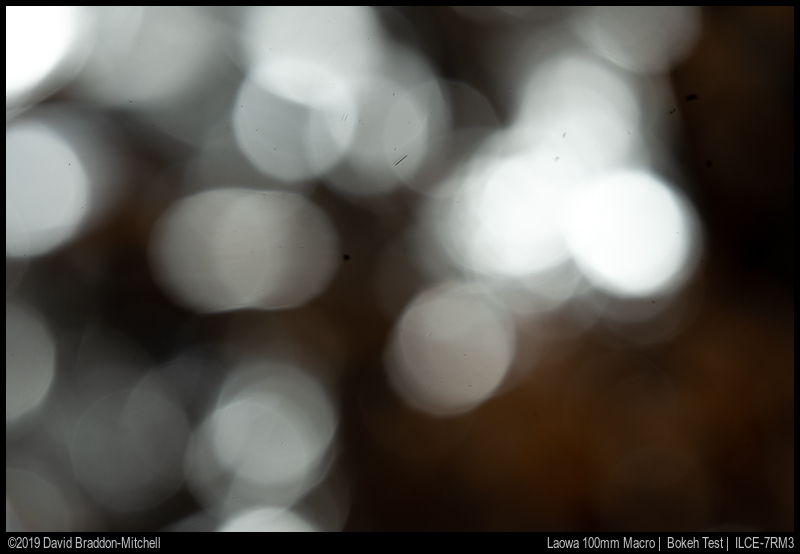











Thanks for the test, I waited for him and waited, The working distance from the front lens is 7.5 centimeters (that’s a bit when the hood is still worn), in the case of a 1: 1 macro, and the working distance for 2: 1 I do not know
Working distance at 2:1 for this lens is 71mm.
(from the filter thread with no hood on)
Do you also know the working distance at 1:1 from the filter thread? (i.e. no hood)
An interesting and surprising lens! And an excellent review, thank you.
I was also surprised to find a few of your sample photos were shot so far from home – your home that is. If I’m not mistaken you were at the Forest Canyon overlook on Trail Ridge Road in Rocky Mountain NP, Colorado, correct?
Ha, well spotted, yes a long way from Australia!
I was travelling for work, one of the places being a conference in Boulder. So I took the weekend and a day of leave to explore the Rockies with some hiking and the trail ridge road (and various short trails off it).
Shutterbug published a review complaining of oozing grease and possible dust ingress. Did you experience either of these problems? Thanks!
I read that too.
What’s going on here is that the outer, fixed lens barrel in which the actual focussing elements move is indeed lined with an even thin layer of grease. Rather more than ideal, perhaps, but given the short throw maybe lubrication is needed here.
My copy of the lens came with a clear filter which seals the outer barrel. I think it is probably essential to keep that in place to prevent dust getting into that grease. If you do, it’s fully sealed.
OK, thanks!
Thank you for your exzellent review!
Really looks to be a great lens and a great buy.
Considering the field curvature:
I’m looking for a macro lens with 1:1 capability to digitize my film negatives. Im currently using the Voigtlander 65mm f2.5 with a Marumi +5 lens to get near 1:1 (usually shooting at f8).
Do you think that the Laowa would be better than that combination as it can do 1:1 natively?
Thank you!
Sahib7,
What do you think of the Marumi? I have been considering one for a similar setup.
The Marumi is nice as it gets the Voigtlander from 1:2 to almost 1:1 (but not quite 1:1 – I digitize 35mm film negatives and the frame fills about 80 percent of the sensor area). But it also introduces distortion. But regarding resolution it is quite nice.
For digitising negatives I think the CV 65 plus Marumi should be all you need; no need to try anything else really (I have a slide copier attached to an FE 2.8/50 macro for this purpose – it stays there except for occasionally when I take that lens hiking). The Laowa might be attractive you want more working distance, or want 2:1. The resolution of the CV + marumi is high enough that any distortion that the achromat adds could be corrected in post.
Thank you!
should be Voigtlander 65mm f2.0
Yes, that’s right!
It’s an f2 lens.
I have this lens with Canon EF mount, but I have a problem with aperture control: it doesn’t automatically open up when shooting live view on a Canon body or via EF-E adpaters. I’ve contacted Laowa and it seems like mine is the only a bad apple from the tree. I like the EXIF logging feature and the automatic aperture, so maybe I’ll keep the lens even though it take some time to fix the problem.
The good thing is the Laowa sales/PA division acknowledged my issue to the tech division, and I’m waiting for the answer from the tech division. I know it will give me some headache, but I’m going to be patient and I’ll watch how good their after sales service would be.
Thanks for the review and the tip about the aperture setting beyond life size.
I think the EF version has fewer iris blades. Whether this makes much difference to stopped down bokeh i dont know, but it might, and if so there will be a trade off between exif and bokeh..
Thanks for the review! I’m tempted…
Btw. the article is tagged only with “uncategorized” while other lens reviews have “lenses” and “review”. Not really important as long as you stay below 5 articles/day, but I thought I’d mention it.
Thanks! Fixed…
Philippe, what about the Minolta md 100 f4 ?
It is a decent 1:2 macro. The Laowa is one or two leagues above and does 2:1 so I find it hard to see it as an alternative.
The link to Sony G 90mm f2.8 Macro is not correct.
Hi, great review.
In Alternatives; the Voigtlander 110mm is f2.5 not 2.8.
Thanks
hello…opinions on the Voigtlander apo lanthar 110,i just got mine Thursday,ive been testing in crappy overcast weather conditions and the images seem great,but none the less would probably look better in better lighting conditions,Though the question is,is it much more better image quality than all the other macro lenses out there?im still thinking of getting the Laowa 100mm for exclusive macro work…opinions appreciated,, thanks
There’s little doubt that the cv 110 is a little sharper and certainly contrastier than the Laowa, but the Laowa is sharp, cheap and does 2:1
Thanks for the great review! I bought this after your and Dustin Abbot’s reviews. I’ve been stunned by how good it is so far. Not just for the money but in terms of outright performance. It may be the best value I’ve ever come across in lenses. I have some nice Zeiss Loxia and Voigtlander APO glass and this absolutely is in the same league as those lenses for image quality. It would be worth double what they charge. At least since its 2:1.
Good review very insightful. after reading this and other reviews I have received the Canon RF version for Christmas and got it early I have only used it a few of times but I am very impressed. I seams as clear as my Canon 100mm f2.L overall I like the 2x option.
Using this lens on 2 sony camera: 7r3 and 7r4a. Unable to find infinity focus. cannot use it for portrait or landscape. Am I using a wrong setup?
Are you using a native Sony lens or do you adapt a lens with a different mount?